The Saint-Victor Institute includes a secondary ASO-school, a BULO-school or a special primary school and three primary schools with infant schools.
The beginning of the 21st century
Alsemberg has three schools: ASO, BULO and primary education. In Beersel and Dworp as well, there is a Saint-Victor primary school. The primary educations have been made part of the community of the schools ”ZONIËNRAND” and the secondary school is part of the community “CARDINAL CARDIJN” that spans the region of Halle. In 2018 the Saint-Victor Institute has 1857 pupils and 182 staff members.
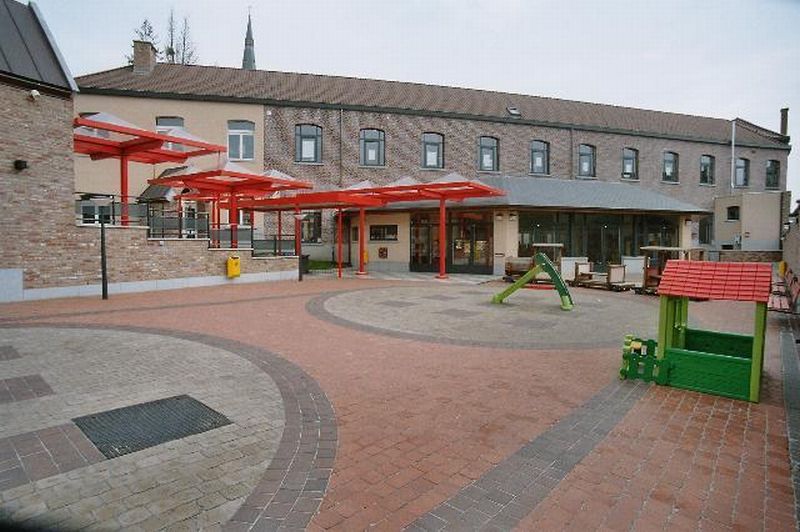
In the three settlements of Saint-Victor, they do a lot of building and renovation works. In the five schools, the sanitary is completely renovated. Four infant classes, a reception room, a new play ground, dining rooms with kitchen and a washing-up room are new since 2004 in Alsemberg. At the beginning of the spring festivities in 2006, they celebrated the new secretary room with speeches, a tour and a reception.
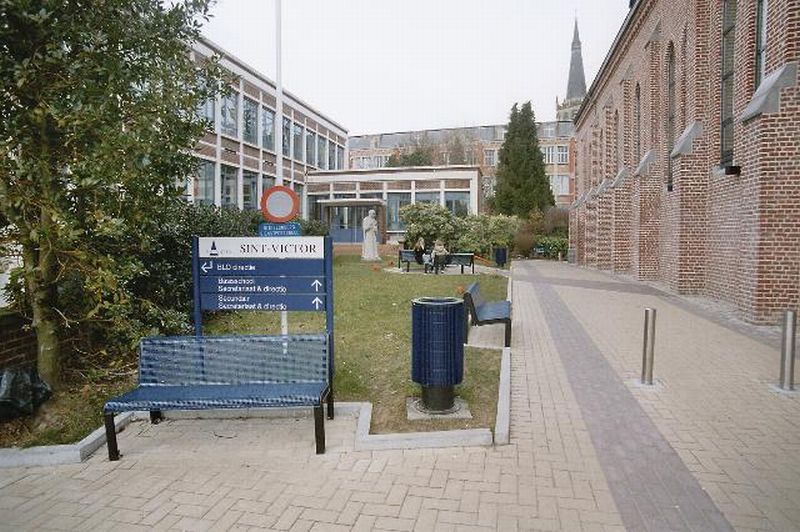
Still a lot of new building concepts are waiting to be done. During the summer holidays of 2004 a few provisional class rooms have been arranged. In 2005 they started with the first phase of the “masterplan” in Dworp.. In Alsemberg, the sanitary block for the secondary school was finished in 2006, as well as the renovated entrance. The same year, they also changed-over from gas to central heating and the renovation of the auditory started as well.
All divisions of the Saint-Victor Institute now dispose of computers and most of them even have a computer network that gives access to internet. An ICT-coordinator takes care of the fact that everything functions optimally.
It all started in 1861
The 27th of August 1861 five Brothers of Scheppers coming from Mechelen arrive at Alsemberg. At the bottom of the church stairs, they’re standing in front of their new home: a boarding school in decay. Cracked walls, mouldered floors, a filthy play ground and a garden, overgrown with weeds was all what was left from the old “THREE KINGS” (Drij Coningen).
Under the supervision of Brother Vincent, the structural engineer of the congregation, and of friar Constantinus, the five pioneers started working and during five weeks they toiled and moiled to break down the miserable house and to renovate it. By their convincing devotion and their kind intercourse, the Brothers slowly gain the confidence and the respect of the civilians of Alsemberg.
The first of October 1861 the new school year can start. Everything has been made ready. Seven pupils are enrolled. Monsignor Scheppers, who was at first occupied by the preparations of the Rome trip, can only consecrate the boarding school at the 10th of October. The first school year closes with thirty boys at the boarding school.
Extension
In 1863 there are already 60 boarders so that renovation and enlargement of the buildings are necessary. A soft winter permits that the whole complex is firmly enlarged.
The uncertain coming in and out of boarders, doesn’t prevent that after the Eastern holidays of 1865 the 150st pupil is enrolled. In expectation of the further enlargement, the friars remain in the smallest possible part of the building.
The education level around 1870
The education level is regularly tested by Brother Cassiaan van Herzele who inspects the classes and who leads the school according to the tradition of the Congregation, that was going back to 1833, when the recently sacred V. Scheppers taught at the Tivoli country house.
Around 1870 the Saint-Victor boarding school takes over a regularly class division and they start working out an educational planning for the primary school at that moment as well as for the main school, that later on will evolve to a lower secondary school.
Further extension

In 1868 they try, for the third time, to lodge 13 Brothers and 110 boarding pupils. The building of two floors contains a chapel, a dormitory, a large festivity room and a few class rooms.
In 1874, again, there is not enough place and again they rebuild. A few days after the opening of the renewed school, Mgr. Scheppers visits the school. In the Parish church of Our Holy Mary, he says the prayers in the mass of the Holy Spirit and preaches from the pulpit.
Mgr.Scheppers in Alsemberg
When his lingering disease doesn’t keep him from coming, V. Scheppers preaches the “retrait” yearly; he hears confession and prepares the children for their Holy Communion. Sometimes, he even takes out that the children for a walk in the undulating landscape between “Zenne and Zoniën”.
Often he surprises them with a souvenir from the Rome-trip. On the part of the children, they meet him at the station of Rode and pay him homage to his name-day with verses and songs at the common festivity meal.
At prize-giving of 1875 Mgr. Scheppers is in Alsemberg for the last time. He may join the fact that 143 pupils exhibit their paintings and their note books for the first time . The death of V. Scheppers on March the 7th, 1877, brings great consternation in his second boarding school that is named after him.

Saint Victor Institute ten years

In 1871, the Saint-Victor Institute cele-brated its tenth anni-versary. On that occasion, Victor Scheppers received a chalice from the pupils with the inscription on the base of the chalice :
ALUMNI TYROCIN II Sti VICTORIS
IN ALSEMBERG; B.M.V. Ja MAJI 1871
A silver jubilee in 1886
In 1886, Saint-Victor already exists for 25 years. Pupils and old pupils honour the Brother community with a solemn thanksgiving mass. In the same year the refectories are built that were renovated as infant classes in 2004.
The Eastern holidays of 1895 are prolonged with 24 days so that the existing chapel could be changed in a dormitory and in a wash room. In the garden a drawing room, a class and a piano-room are built, that are demolished again when the “Normaalschool” is built.
The Neo-Gothic chapel and the entrance building

On Friday, the 10th of May 1897, the Superior of the Brothers laid the foundation – stone of the Neo- Gothic chapel, now rebuilt as a polyvalent room. In the same year the old “Schuttershuis”, later called “The Drij Coningen”, was broken down and became the main entrance. There rises the imposing entrance building in Neo-Flemish Renaissance style, with a front garden and a monumental entrance fence, where the community of Brothers is living nowadys.
The golden jubilee festivities in 1911

Almost 250 boarders, the highest number since 1861, are celebrating the 50 years of existence. The solemn mess is celebrated by Mgr. Sebastiano leite de Vasconcellos, bishop of Beja in Portugal, who was banished over here. At this occasion, a manned balloon, which was a custom in Alsemberg, was launched from the football field, then still situated in “The Dreef”.
The First World War
In very difficult circumstances teaching is continued in the Institute till the summer holidays of 1916. Then the boarders are sent home indefinitely, because the occupier makes the school to be closed under the pretext of scarcity of coal. Only the non-residents are still taught during three months until this is also forbidden.

Brother Pascal, who devoted his best energy to teaching and education, becomes seriously ill and dies on the 12th of December 1916 at the age of 74 years old. That means the end of a sixteen year growth of Saint -Victor , thanks to this exceptional monk.
In 1917 the “Juvenists” from Anderlecht are settling in Alsemberg. A bit later, 216 war orphans from occupied France, especially from Saint- Quentin, are taken in in the Institute. The friars had a lot of difficulties in replacing the parents of these children, aged from seven to fifteen.

The learning instructions of the primary school were almost finished. Meanwhile, Brother Chrysostoom, begs as a real protective father, over the children for food, nourishment and clothing.
Four months after Armistice, the French Government orders the war orphans to be repatriated through “Southkote”. The French war committee expresses the friars the highest honour because of their charity work.
Reopening of the Institute after the war
Brother Justinien Verelst gets the difficult task to reopen the Institute after Armistice in 1918. He starts the difficult postwar period with a good result, because only one year later 180 boarders are enrolled. More and more non-residents are permitted. The Brothers restart a complete new primary school and three secondary classes.
Scheppersnormaalschool
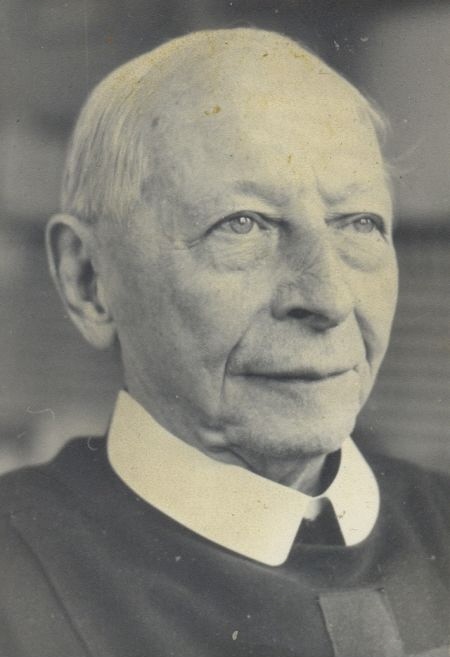
When in November 1921 the “Scheppers-normaalschool” moves from Mechelen to Alsemberg, the two highest classes are omitted because of lack of place. Brother Theodoor De Koninck, founder of the Normaalschool, becomes headmaster of the Institute.

A second sixteen year growth imme-diately starts. In 1931 the foundationstone of the “Normaal-school” is laid. That is inaugurated in 1932.
From the First of September 1984 onwards, the Scheppersnormaalschool became a division of the Normaalschool for girls , the Saint Ursula Institute in Laken. After a few years this division is shut down and this means the end of the Scheppersnormaalschool.
75 year and a centenary
In 1936 Saint-Victor celebrates its 75 years of existence. In 1937 the number of pupils rises to 417 in the boarding school and to 143 in the Normaalschool. In 1939 the foundation of Congregation in 1839 is commemorated.
During this period there is a very busy art and literary activity in Saint-Victor. It develops especially under the impulse of Henry Diddens, Albe (Renaat Joostens), Brother Theodoos Lemmens., Willem Savenberg and a few other inspiring persons.
The Brothers Juul and Cassiaan Francken are also very active. All this evolves within the atmosphere of the somehow exaggerated Flemish Romanticism around the Rodenbach myth, but there is devotion and enthousiasm.
The Second World War
In 1939 Mobilization starts. Al lot of Brothers were called up. They are replaced as well as possible. But in September, there is uncertainty: will the lessons retake? At that very moment, the school has become a military headquarter.
In the classrooms two generals, two colonels and about fifteen officers had installed their office. The refectory of the youngest pupils is an officer’s mess room; the other one will become a dormitory. If the lessons must retake, they will evacuate the school in time.
During the war, the school has known no German occupation, thanks to the burgomaster of Alsemberg, Emiel Dielen. But, Germans officers who are staying in the Bosquet castle, although use the bathing room. During that war period, the Institute has never been closed.
Keeping the boarding school open, asks a lot of courage and daring. Feeding hundreds of hungry stomachs is certainly not an easy task. Without cheating the occupier or avoiding the controls, that is impossible.
A Dutch remake
During the school year 1941-1942, Saint-Victor has become a Dutch school. On the 19th of December, the headmaster Brother announces the chairman of the “sanction board” that Saint-Victor has become a Dutch school.
Dutch is now the First language, although French is still obliged to speak during three days of the week. The French prayer-books are replaced. Friars and pupils can now freely speak their mother tongue. In July 1943 the first Dutch certificates of the secondary division are given.
A large expansion
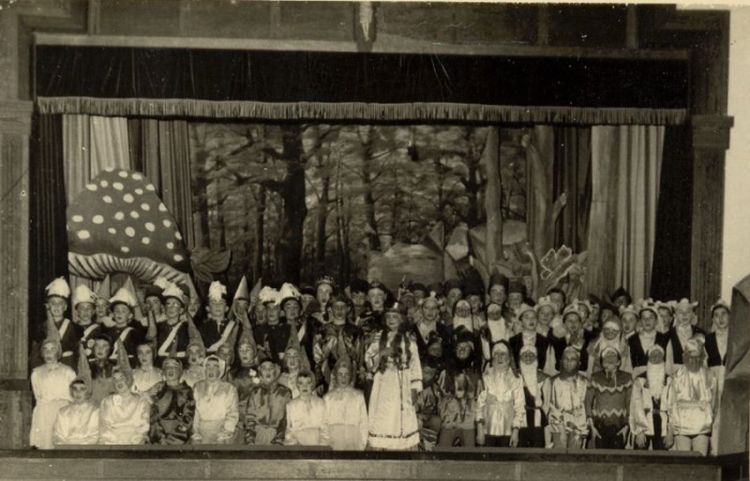
In 1953 Brother Cassiaan Francken starts his headmaster’s period. This means a boom for Saint-Victor. Ten dormitories are full of boarders. The number of pupils rises from 270 in 1953 to 522 in 1959.
A theatrical performance with 120 actors, the choir of Brother Martial, The K.S.A-division, the A.B.N. afternoons mobilize a great deal of the school population.
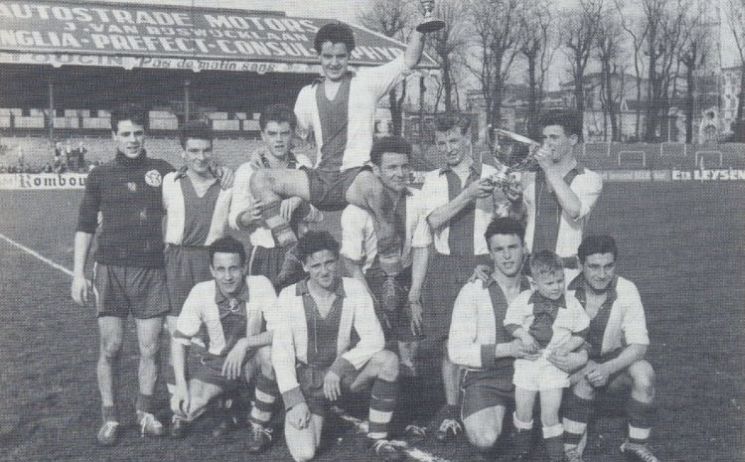
In lots of cases,the sports demonstrations become real heroic events, like the conquest of the “Cardinals Cup”. “Summer matches” really become passionate duels. During the holidays they organize summer camps and bicycle trips in the Ardens.
This is the last period in which only Brothers stimulate the Saint-Victor life. This effervescent family school life in that safe boarding nest is immortalized in dozens of photographs by Brother Petrus.
The first laymen
In 1943 the first layman is recruited as a teacher and in September 1945 Rik Dhondt and Karel Grijseels start their teaching in Saint-Victor. But, most of the teachers are still Brothers until the sixties, because then, with the massive growth of pupils, the laymen, who were often old pupils, rise equally year after year.
Thanks to the positive welcome climate, the Brothers have caught a complete team in the Saint-Victor life. By participating in different festivities and by giving evening study, these laymen of the first rank become completely integrated in the typical environment of Saint-Victor.
In those years the Congregation has always exerted herself to promote the apostolic cooperation between laymen teachers and Brothers. The 24st of April 1963, Brother assistant Omer Claes, conducts a conference in the Scheppers Institute in Mechelen for all the teachers from the Scheppers schools.
Permanent constructing
On the 2nd of September 1952 the first foundation stone is laid for the construction of two play halls and a sanitary building. In March 1956 they continue the building above the sanitary part: four classrooms and rooms for the Brothers . In 1960 a culture centre is furnished.
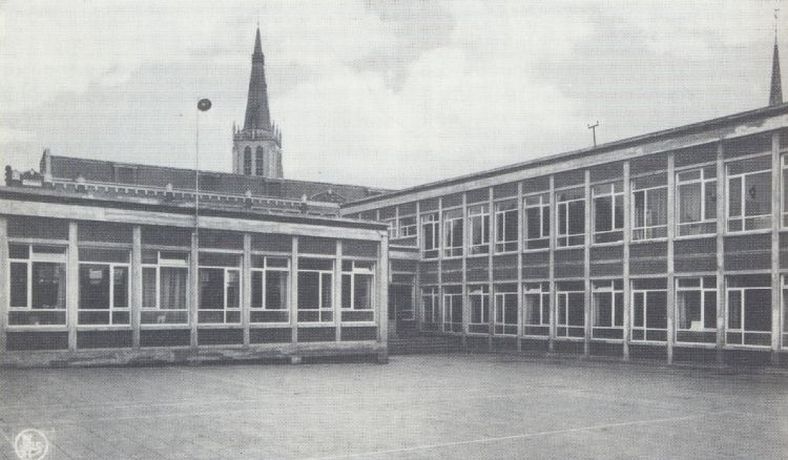
In 1959 they start the Construction of the new primary school in the gardens, in which, in former times, the chicken pens were installed. In September 1960 the primary school breathes again in brand-new classes. This new building was urgent, because the number of pupils always rises.
In September 1964 there were 729 pupils enrolled, of which 341 study humanities. There are far too few class rooms. In 1965 the construction of three classes above the new sanitary building starts, as well as an auditory that will be put into use in September 1966.
A centenary in 1961
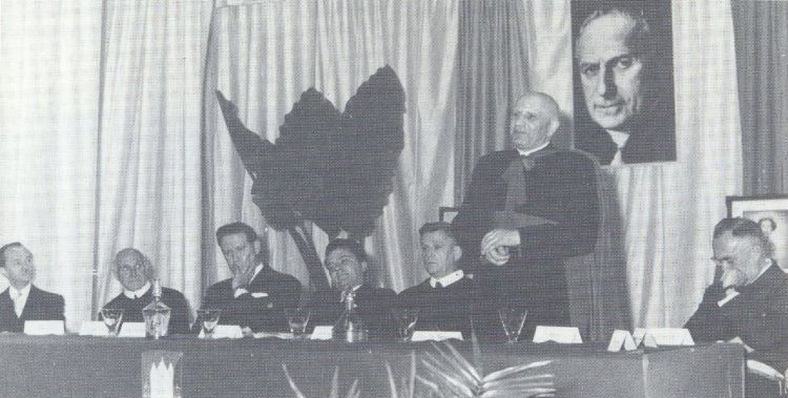
The celebration of 100 years Saint-Victor takes four days: from May the 11th till the 14th. The centenary is under cover of The King Boudewijn, Cardinal Van Roey, Mgr. Forni, “Apostolic Nuntius”, Mgr. Daem, general headmaster of the catholic education, The province-governor of Brabant, de Néef, Brother General Superior Jaak De Winter and Bourgomaster Jean Albert.
At the academic session in the municipal festivity hall, Minister Van Elslande was the orator. One hour later, Brother General Superior unveils the statue of Mgr. Scheppers on the place near the primary school. This statue is offered by the pupils, the parents, the old pupils and the friends of Saint-Victor. It is a work from the sculptor Liévin Laeremans from Bonheiden and it is 2,20m high.
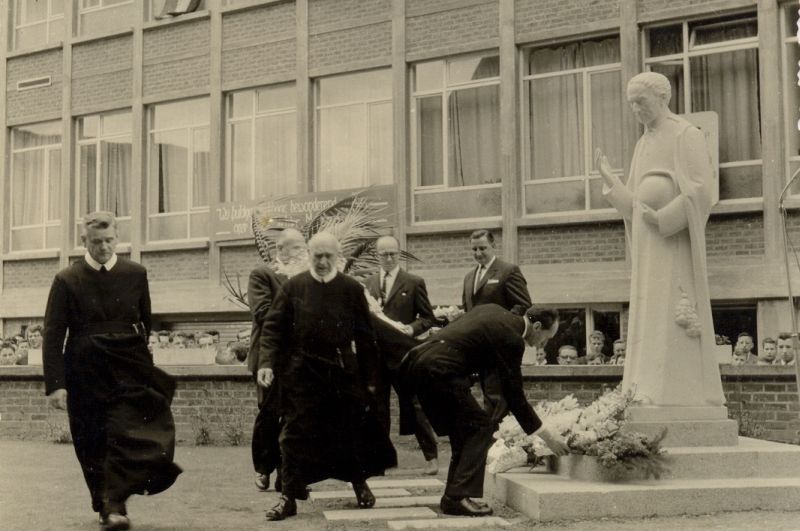
When Saint-Victor celebrates its 100 years of existence, the Institute has already taken a high flight that includes different education divisions. In the primary school they count 295 pupils, taught by eleven teachers. In the modern humanities, with a scientific A division and an economic division, there are nineteen teachers for 254 pupils.
In the youngest Latin-scientific division, there are ten teachers for 49 pupils, while in the “lower” school for teachers 97 future teachers are educated by 12 teachers. Together, the school population is now 695 pupils and they’re taught by 52 teachers.
Class reunions and the board council
In 1965 the headmaster Amedée Drieghe arranges class reunions and this for the first time, in which the board, the Brothers and the laymen work together on the concept of a pedagogical and a psychological approach for each group of pupils that continuously evolves from an real boarding school to an almost exclusive day school.
In 1968 a board council is founded for all the Saint-Victor schools. In this board, headmaster Brother Amedée Drieghe is chairman, besides him are also present Brother headmaster Mattheus from the “Normaalschool”, Brother Martinus Bex from the primary school, two representatives of the parents committee and also two teachers for each division of the school. Two pupils from the humanities and from the “Normaalschool” are also adapted in the committee. Along the years this committee has certainly improved the contacts and the understanding in the whole school community.
The BLO-division and the end of the boarding school
In 1969 the BLO division starts. In the beginning the headmaster of the primary school is also headmaster of the BLO. Later, when this division becomes autonomous, the primary school has a few very bad years.
The pupils of the BLO don’t count anymore in the primary school and especially, the number of boarders diminishes year after year. In 1965 there were still 100 boarding pupils for the primary school but this number decreases till 21. On June The 30thst 1978, this means the end of the boarding primary school. The boarding school of the humanities had already ended in 1976.
Female teachers and mixed education

In September 1973 the First female teacher enters in the humanities. She is the forerunner of a trend that knows an enormous rapid. In the primary school there were already two female teachers.
The First girls entered in 1974. The “Normaalschool” could start up with mixed education from the first of September 1977. In September 1981 the humanities also become mixed.
Three primary schools in 1976

Having the urgent fusion of the municipalities in prospect, the diocesan inspection insists on the fact that the Catholic Schools in the future municipality “GREAT BEERSEL” should be brought together under one institutional authority.
An agreement is reached with the Sisters of Vorselaar for the school in Dworp (Alsembergsesteenweg) and also with the Sisters of seven woes of Saint-Genesius-Rode for the girls school in Beersel (Hoogstraat). In August 1976 the fusion between the primary schools of Beerse, Dworp and Alsemberg becomes a fact.
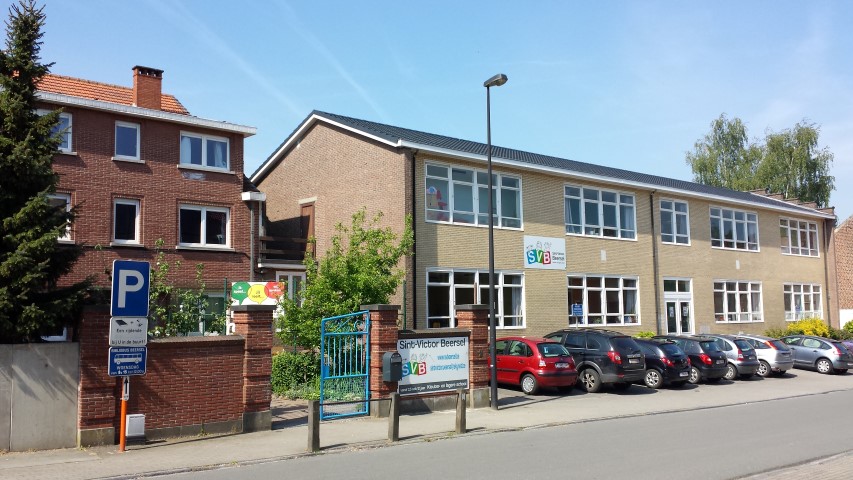
In September 1984, the primary school in Alsemberg starts with an infant class of 24 tods. The 4th of March 1985, a second class is opened. Beersel and Dworp already had an infant school linked with the primary school.
125 yaer jubilee in 1986
The celebration of 125 years existence is prepared carefully. The chairman of the festivity committee, Tavi Theys, continuously works for about two years. The celebration itself takes 7 days. The jubilee festivity is opened on Saturday 24th of May with a school feast at 20u.
The day after is a well willed festivity happening. At 10u there is a flower homage at the statue of Mgr. Scheppers, followed by an academic seating in the Meent; then a reception follows at 13u, followed by a banquet
As a result of the 125 years of existence of the Saint-Victor Institute Marcel Debremaeker edits the book "The history of the Saint-Victor Institute and the Scheppersnormaalschool in Alsemberg"
150 years of existence in 2011
The celebration of the 150 years of existence of the Institute will last for almost a whole year in 2011-2012.

The 25th of September 2011: solemn opening of the 150 years of existence of the Saint-Victor Institute with a celebration of the Eucharist in the ducal Church “Our Holy Mary” of Alsemberg.
This was followed by an academic session, consisting of five orators, alternated with musical intermezzo’s by the Saint-Victor choir and the musicians Dirk Van Leuven en Peter Savenberg.

The 13th of September there was a festal healthy breakfast at the schools for about 1800 pupils as well as for the personnel. This was the start of the festal 150 years of Saint-Victor.

Renovations in the 2020s
The building, which was located to the left of the stairs, was almost completely demolished because of stability problems due to the soggy ground. For this reason, the floor was demolished earlier. So the current building on that site is actually a new building. The building on the right, on the other hand, has been renovated.

At the bottom are the Hall of Scheppers and the Teacher's Room. Classrooms are located on the upper floors.





